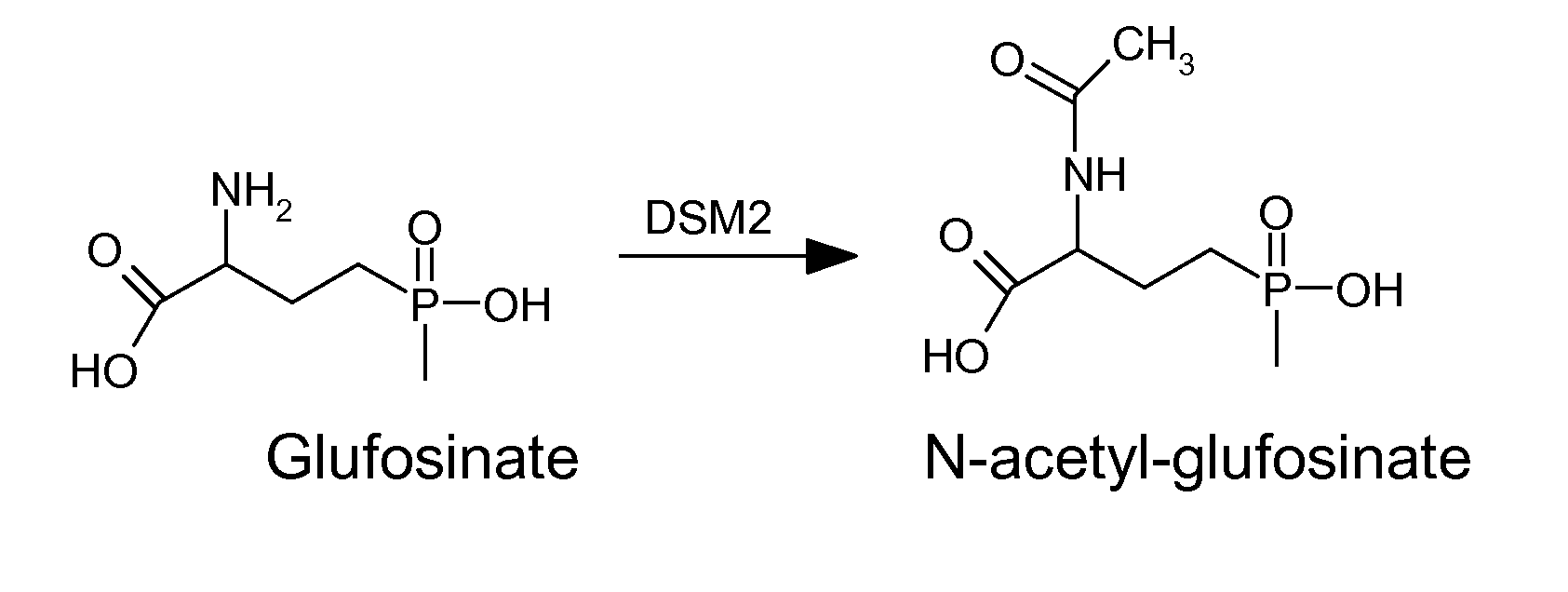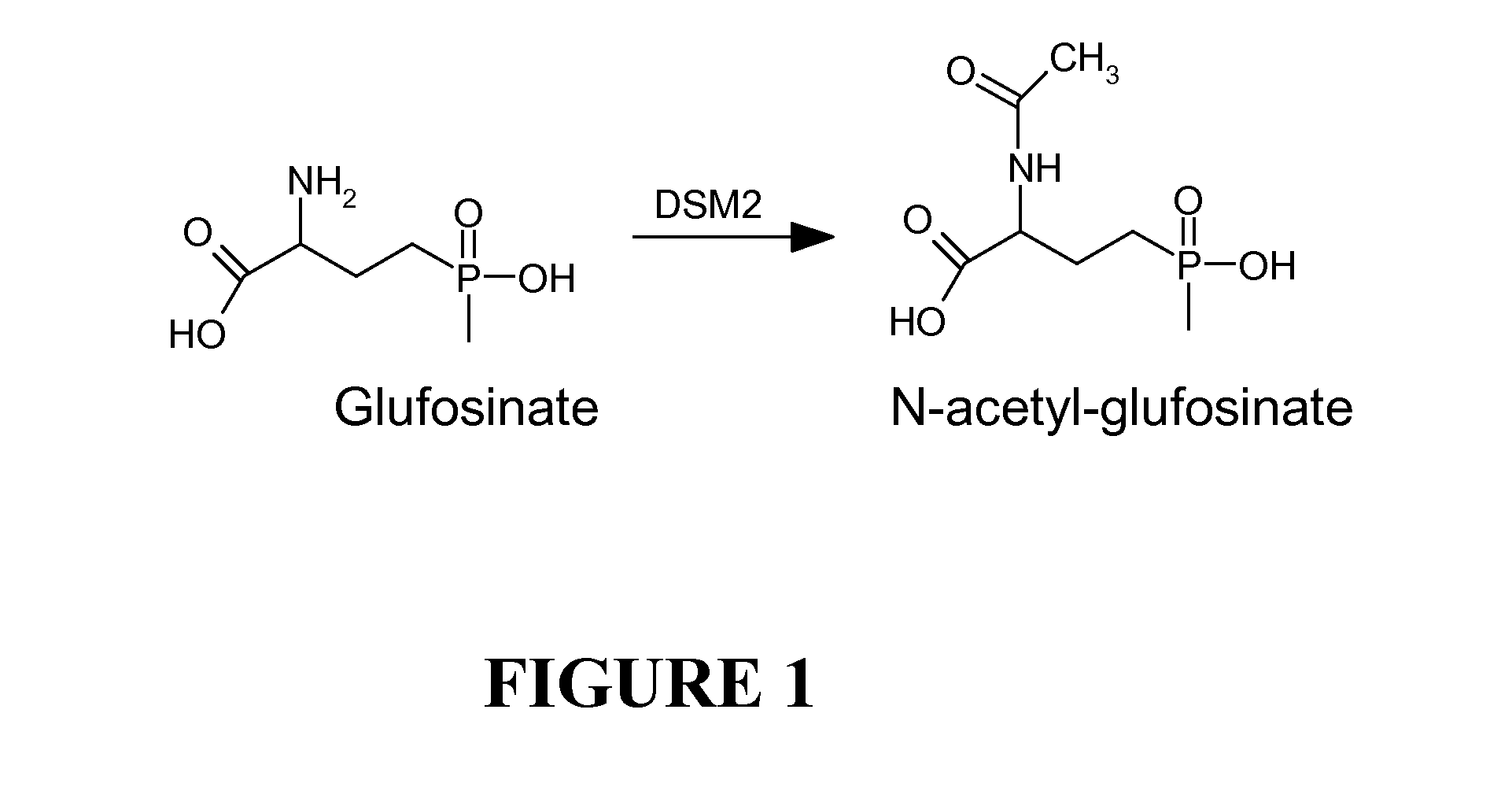Constructs for Expressing Herbicide Tolerance Genes, Related Plants, and Related Trait Combinations
a technology of gene expression and gene expression, applied in the field of constructs for expressing herbicide tolerance genes, related plants, and related trait combinations, can solve the problems of rapid accumulation of ammonia and death of plant cells, the total destruction of potent inhibitors of gs, and the toxicity of plant cells, etc., and achieve excellent tolerance and/or resistance.
- Summary
- Abstract
- Description
- Claims
- Application Information
AI Technical Summary
Benefits of technology
Problems solved by technology
Method used
Image
Examples
example 1
Method for Identifying Genes that Impart Resistance to Glufosinate in Planta
[0100]As a way to identify genes which possess herbicide degrading activities in planta, or cell culture, it is possible to mine current public databases such as NCBI (National Center for Biotechnology Information). To begin the process, it is necessary to have a functional gene sequence already identified that encodes a protein with the desired characteristics (i.e., phosphinothricin acetyltransferase). This protein sequence is then used as the input for the BLAST (Basic Local Alignment Search Tool) (Altschul et al., 1997) algorithm to compare against available NCBI protein sequences deposited. Using default settings, this search returns upwards of 100 homologous protein sequences at varying levels. These range from highly identical (85-98%) to very low identity (23-32%) at the amino acid level. Traditionally only sequences with high homology would be expected to retain similar properties to the input seque...
example 2
Optimization of Sequence for Expression in Plants and Bacteria
[0102]2.1—Background.
[0103]To obtain higher levels of expression of heterologous genes in plants, it may be preferred to reengineer the protein encoding sequence of the genes so that they are more efficiently expressed in plant cells. Maize is one such plant where it may be preferred to re-design the heterologous protein coding region prior to transformation to increase the expression level of the gene and the level of encoded protein in the plant. Therefore, an additional step in the design of genes encoding a bacterial protein is reengineering of a heterologous gene for optimal expression. See e.g. Kawabe et al. (2003), “Patterns of Codon Usage Bias in Three Dicot and Four Monocot Plant Species,” Genes Genet. Syst., pp. 343-352; and Ikemura et al. (1993), “Plant Molecular Biology Labfax”, Croy, ed., Bios Scientific Publishers Ltd., p. 3748), and all relevant references cited therein.
[0104]One reason for the reengineerin...
example 3
Cloning of Transformation Vectors
[0113]3.1—Construction of Binary Plasmids Containing DSM-2 (v2)
[0114]The DSM-2 (v2) codon optimized gene coding sequence (DASPIC045) was cut with the restriction enzymes BbsI (New England Biolabs, Inc., Beverly Mass., cat #R0539s) and Sad (New England Biolabs, Inc., cat #R0156s). The resulting fragment was ligated into pDAB773 at the corresponding restriction sites, NcoI (New England Biolabs, cat #R0193s) and SacI. Positive colonies were identified via restriction enzyme digestion. The resulting clones contained the Rb7 MAR v3 / / At Ubi10 promoter v2 / / gene of interest / / Atu Orf 1 3′UTR v3. The plasmid that contained DSM-2 (v2) as the gene of interest were labeled as pDAB3774.
[0115]The Rb7 MAR v3 / / AtUbi10 promoter v2 / / gene of interest / / Atu Orf1 3′UTR v3 cassette was cloned into the binary vector pDAB3736 as an AgeI (New England Biolabs, Inc., cat #R0552s) restriction fragment. This cassette was cloned between the Left Hand and Right Hand Borders of the b...
PUM
| Property | Measurement | Unit |
|---|---|---|
| concentrations | aaaaa | aaaaa |
| temperatures | aaaaa | aaaaa |
| melting temperature | aaaaa | aaaaa |
Abstract
Description
Claims
Application Information
 Login to View More
Login to View More - R&D
- Intellectual Property
- Life Sciences
- Materials
- Tech Scout
- Unparalleled Data Quality
- Higher Quality Content
- 60% Fewer Hallucinations
Browse by: Latest US Patents, China's latest patents, Technical Efficacy Thesaurus, Application Domain, Technology Topic, Popular Technical Reports.
© 2025 PatSnap. All rights reserved.Legal|Privacy policy|Modern Slavery Act Transparency Statement|Sitemap|About US| Contact US: help@patsnap.com


